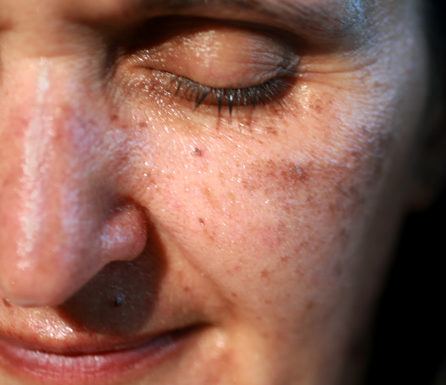Sometimes we notice what appears to be moles or freckles on our hands or other areas of our body that are exposed to the sun, such as our shoulders or our face. When spots like this appear, the smart thing to do is make a visit to your dermatologist. Most of the time these spots are nothing to worry about, but it’s always best to get them checked. These spots are infamously called “age spots” or “liver spots”. Solar lentigines or senile lentigo may be called age spots but they don’t appear exclusively on the elderly. Anybody of any age, as well as race or gender, can get them.
Though age spots most often appear on exposed areas of the skin, the reason they appear is still unknown. When there is an increase in melanin in a specific area they appear. Melanin is the pigment that gives skin its color.
SIGNS AND SYMPTOMS
Age spots range in color from tan to black and feel the same as the rest of the skin. They are not raised and are painless and harmless. However, not everything that appears to be an age spot is just that. If there is anything abnormal about the spot, you may need a biopsy.
RISKS
Age spots can appear at any age, however the chances of getting age spots does increase with age. Age spots are more likely to be found on people over 40, people with fair skin and those who spend a lot of time in the sun or who frequent tanning salons.
HOW TO TREAT AGE SPOTS
Since age spots don’t pose a threat to our health, they don’t need to be treated. However, if the aesthetics of them are unappealing, there are removal options. It is best to speak with your dermatologist about the treatment options.
Topical treatments include creams that contain hydroquinone, a bleaching agent. Sometimes hydroquinone is combined with retinoids, aka vitamin A. Hydroquinone takes a few months to work, and during that time it is important to avoid exposure to the sun. It is essential during this time to use a good sunscreen, wear a wide-brimmed hat and clothes that cover most of our body. At Adult and Pediatric Dermatology, we offer a unique, patented, stabilized formulation of ascorbic acid-based hydroquinone, which is more effective and achieves results more quickly.
There are minimally invasive procedures to remove sun spots. Dermabrasion uses a burr to remove the topmost layer of skin. Chemical peels are different types of gentle acids – mostly derived from natural sources – that can be used to exfoliate the skin. Different strengths can be used to remove age spots. Intense Pulse Light (IPL) is a gentle, non-ablative treatment using broad-spectrum light to treat skin concerns such as age spots. IPL can show results in as little as 1-2 treatments. Cryosurgery is slightly more invasive, using liquid nitrogen to freeze and destroy sun spots.
THE DIFFERENCE BETWEEN SEBORRHEIC KERATOSIS AND AGE SPOTS
Seborrheic keratosis is another pigmented growth that appears on the skin. Like age spots, seborrheic keratoses are pearl to brown-black in color. They typically occur after the age of 30 and are the most common pigmented lesion that brings patients to the dermatologist. Unlike age spots, they are scaly, raised and have a waxy texture. Seborrheic keratosis are benign growths we all develop with maturity. These pesky spots (also known as liver spots, age spots, wisdom spots) have traditionally been treated with liquid nitrogen – or “freezing” – which can be painful and leave scars. Introducing Eskata®, the new topical treatment for these unsightly spots on the head and neck. This treatment offers less downtime and decreased risk of scarring.
Call us today at 913-469-1115 to schedule an appointment to see if Eskata is right for you or to discuss other treatment options for age spots. Our caring professionals are here to help with all your dermatology needs.

